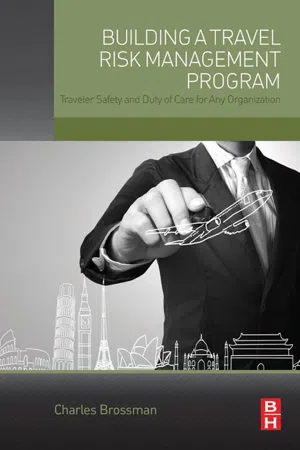
Building a Travel Risk Management Program
Traveler Safety and Duty of Care for Any Organization
- 222 pages
- English
- ePUB (mobile friendly)
- Available on iOS & Android
Building a Travel Risk Management Program
Traveler Safety and Duty of Care for Any Organization
About This Book
Building a Travel Risk Management Program: Traveler Safety and Duty of Care for Any Organization helps business and security professionals effectively manage traveler risk by showing them how to build a complete travel risk program. While global corporate travel risks are increasing exponentially, many security and business managers are not well-versed in the rapidly changing global landscape of travel risk, nor do they fully realize the multitude of risks their companies face if they don't comply with their legal obligations—"duty of care"—for protecting their employees from foreseeable harm, which can cost a company in the form of extensive fines, productivity loss, business interruptions, stock price loss, litigation, and even potential bankruptcy.
This book is the first to bridge the gap between the topics of travel management, security, and risk management. It serves as a reference point for working with other departments, including human resources and legal, paving the way for better internal cooperation for travel managers and security managers. In addition, it helps organizations craft a travel risk management program for their unique needs that incorporates the most important policies and procedures that help them comply with legal obligations.
- Illustrates common mistakes that can have a devastating impact across the entire enterprise with real-world examples and case studies
- Includes testimonies from corporate travel risk security experts on best practices for meeting the constantly changing duty of care standard
- Presents best practices for reducing the risk of exposure and liability
- Offers models for effectively promoting and advocating for travel risk management programs within the organization
- Compares laws like the UK"s "Corporate Manslaughter Act" (considered one of the world's most strict legislative standards) to similar laws around the world, showing how compliance requires constant supervision and process improvement
Frequently asked questions
Information
Planning for known and unknown risks
Abstract
Keywords
Legal duty of care—definition1





Table of contents
- Cover image
- Title page
- Table of Contents
- Copyright
- Foreword
- Introduction
- About the Author
- 1. Planning for known and unknown risks
- 2. Assessing your current approach to travel risk management
- 3. Building a proactive travel risk management program
- 4. Travel risk policies, compliance, and supplier safety
- 5. Crisis response
- 6. Kidnap and ransom, extraction and evacuation
- 7. Hotel safety
- 8. Conferences, meetings, and incentive trips
- 9. Enterprise risk management and its relation to travel risk management
- 10. Travel management companies
- 11. Finding the money for travel risk management
- 12. TRM – setting new standards for what’s to come
- Index